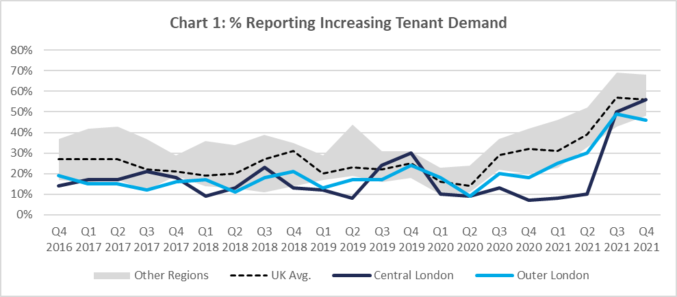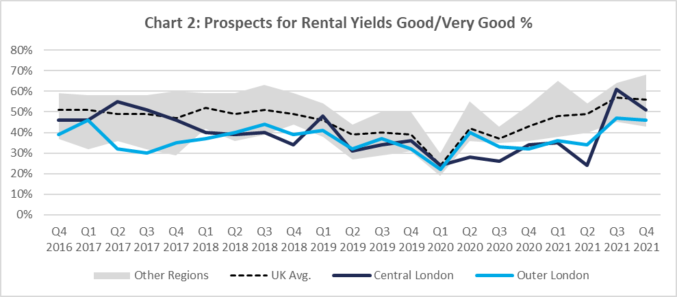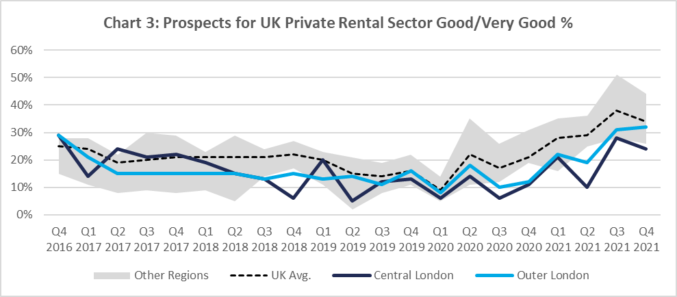OSB Group reports green shoots for landlords in London
By Specialist Finance Directory -
Green shoots are appearing in London according to data analysis by the in-house Insights Team at specialist mortgage lender, OSB Group, home of Precise Mortgages, Kent Reliance for Intermediaries and InterBay.
The analysis tracks a number of historical variables sourced from BVA BDRC and discovered that although landlords operating in London generally remain less optimistic than in other parts of the country, there has been a definite bounce back in confidence in the region for the first time since the start of the COVID-19 pandemic as renters return to the city.
Tenant Demand
The data shows that tenant demand in London has tracked below the UK average since the first national lockdown was implemented in March 2020, with 10% or fewer of landlords operating in Central London reporting increasing tenant demand for three consecutive months from the fourth quarter of 2020.
In comparison, UK regions have on average reported steadily increasing tenant demand since a low point during the first national lockdown.
This recovery has picked up pace in recent quarters and Central London has recently observed a particularly sharp recovery in demand, jumping from just one in ten landlords reporting increasing demand in the second quarter of 2021 to more than half of all respondents in the fourth quarter.
Rental Yield
With this increasing demand, the proportion of UK landlords reporting positive prospects for UK rental yields has also trended upwards from a low point at the start of the pandemic.
Despite this, Central and Outer London were the two worst-performing regions in four consecutive surveys from the third quarter of 2020.
The third quarter of 2021 saw confidence in rental yields in both London regions (central and outer) increase to an all-time high in the series, which spans back to late 2016.
Central London jumped from the lowest-ranked region in the second quarter of 2021 to exceed the national average in quarter three for the first time in over two years.
There was also a drop in confidence nationally in the fourth quarter, which was particularly pronounced in Central London, suggesting that this coincided with the introduction of the “Plan B” measures which once again mandated mask-wearing and working from home which may have resulted in a temporary drop in confidence.
Despite this dip, London landlords’ prospects for rental yields at the end of the year remained higher than any other point since 2017.
UK Private Rented Sector
In line with the tenant demand and rental yield prospects, landlords’ overall confidence in the UK PRS has trended upwards from a low point in Q1 2020.
Landlords operating in the Capital remain amongst the most pessimistic in this series but they can no longer be considered an outlier following a significant increase in the number of respondents saying prospects are good or very good in the two most recent Landlords Panel surveys relative to other UK regions.
Landlords operating in London have consistently ranked amongst the most pessimistic over a number of years, but for good reason – they have witnessed the most significant impact as a result of the pandemic, with 3 in 4 landlords operating in Central London saying their lettings business has been negatively impacted by COVID-19.
They have also seen capital gains slow as a result of slower property price growth in the region, with ONS data for November 2021 showing that annual price growth in London was just 5.1% compared to a national average of 10.0%.
However, with lockdown restrictions now eased and becoming less likely to return, landlord confidence is starting to rebound across a number of confidence indicators as rental demand returns in the region.
Roger Morris, pictured, Group Lending Engagement Director, OSB Group said:
“One of the biggest reasons the buy to let market in London was hit hardest during the pandemic is because a large amount of property was rented on a short-term let basis.
During the pandemic, the demand for short-term let properties fell sharply and flooded into the long-term rental market, further impacting this fragile rental sector.
There was a clear trend also showing that many renters returned back to their family homes where they could see their families, save on rent and have increased access to outdoor space.”
But this more recent data shows that the economy is showing signs of positive change, with the buy to let market slowly returning as more properties go back on the short-term rental market in London as demand grows, reducing the volume of long term let properties available.
Renters that had relocated outside of London are now returning, possibly missing the city’s vitality but also in response to employers requesting staff to return back to the office.”
Mark Long, Director, BVA-BDRC added:
“We are delighted to support the OSB Group using our landlord survey data in this way.
It’s clear that, notwithstanding some Omicron related blips in Q4, that London based landlords are in a much optimistic state of mind than at the start of the pandemic, and we will continue to track PRS dynamics including regional trends and the health of the London rental market going forward.”














You must be logged in to post a comment.